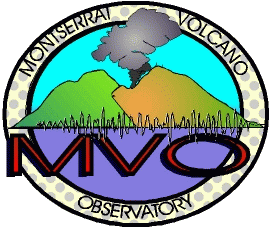

Executive Summary
Introduction
Background
The Concept of Risk
Definitions
Classification of Risk
Quantitative Risk Assessment
Approach and Method
Results of the Monte Carlo simulation of casualty rates
Qualifications
Ranking Hazards and Implications for Risk Mitigation
Warnings
Effectiveness of Warning Communication
Implementation of appropriate action
Mitigation
Engineered Mitigation
Improved Warning
Public Education
Emergency Planning
Health Effects of Volcanic Ash
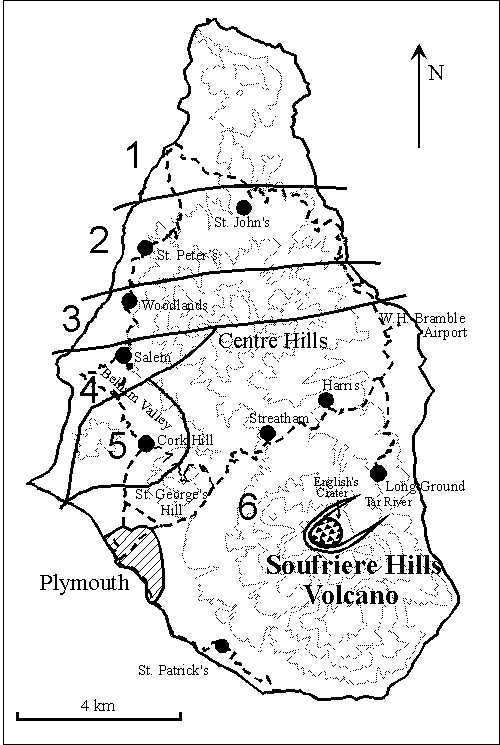
Figure 1: Key features of Montserrat and population zones (900x635 GIF, 6.5K -- 1225x865 GIF, 10K
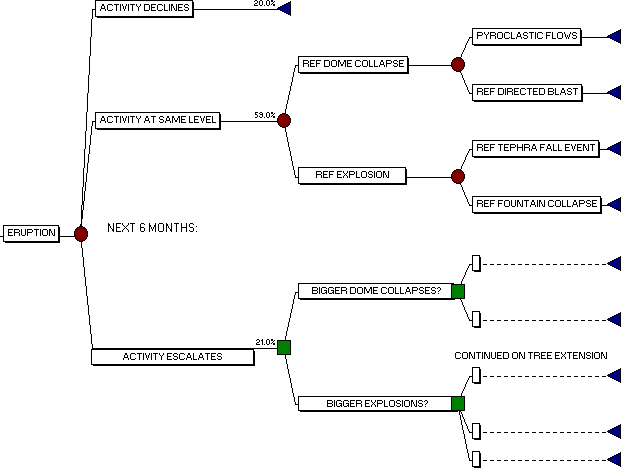
Figure 2a Logic tree for relationships between future activity, events and hazards. Ranges for the event probabilities not shown are given in Table F.2. (830x605 GIF, 8.2K)
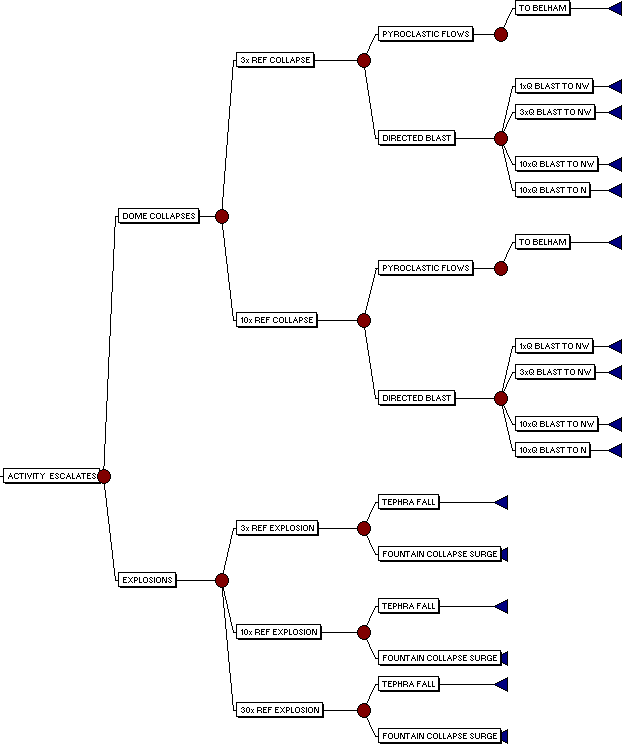
Figure 2b Continuation of logic tree (above) for scenarios involving an escalation in activity. Ranges for event probabilities are given in Table F.2. (790x915 GIF, 10K)
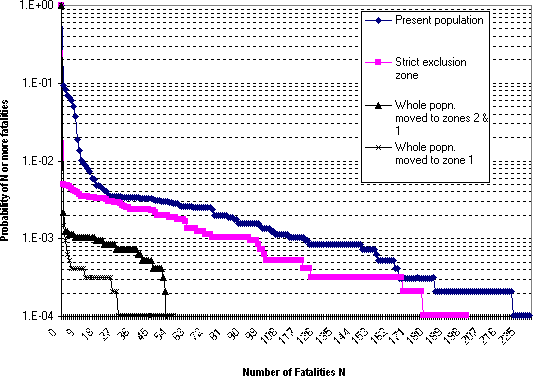
Figure 3: Cumulative probability for fatalities in the four population scenarios. (945x670 GIF, 12K)
Table 1 Probability of N or more fatalities (for six months) for different population distributions.
Population model
N = 1
N = 5
N = 10
N = 50
Current situation
9 - 13%
2.5 - 5%
1.0 - 1.5%
0.3 - 1.0%
Strict exclusion
0.35 - 0.5%
0.32 - 0.45%
0.26 - 0.35%
0.2%
North of Lawyer's
0.18 - 0.22%
0.12%
0.10%
0.03%
All in area 1
0.12 - 0.15%
0.04%
0.04%
0.02%
Table 2 Annualised individual risk of death by volcano in each population area. The CMO's scale is given in Appendix B.
Individual risk
Area 5
Area 4
Area 3
Area 2
Area 1
Numerical odds
1:100
1:450
1:5,000
1:120,000
1:200,000
CMO scale
HIGH
MODERATE
LOW
MINIMAL
MINIMAL
Table 3 Approximate number of deaths for given probability exceedance levels.
Population model
1 in 10,000
1 in 1,000
1 in 100
Current situation
>= 200
>= 120
>= 10
Strict exclusion
>= 180
>= 90
>= 1
North of Lawyer's
>= 50
>= 20
>= 0
All in area 1
>= 40
>= 1
>= 0
Table 4 Hazard scenarios with risk of 5 or more casualties in the next six months,
ranked in probability order and assuming the current population distribution.
Hazard scenario
Approximate
probability of eventExpected
number of
fatalities
10 million m3 dome collapse, pfs down Belham
1:10
5
30 million m3 dome collapse, pfs down Belham
1:125
15
10 times power ref. explosion - fountain collapse surges
1:500
100
10 times power ref. explosion - tephra fall in E-W wind
1:1,000
10
30 times power ref. explosion - fountain collapse surges
1:2,000
190
100 million m3 dome collapse, pfs down Belham
1:2,000
115
30 times power ref. explosion - tephra fall in E-W wind
1:3,000
40
Collapse with 3 times power ref. explosion causing blast to NW
1:4,000
40
10 times power ref. explosion - tephra fall to N and NW
1:8,500
40
Collapse with 10 times power ref. explosion causing blast to N
1:10,000
80
Other collapses followed by lateral blast
1:10,000 to 1:1,000,000
190 plus
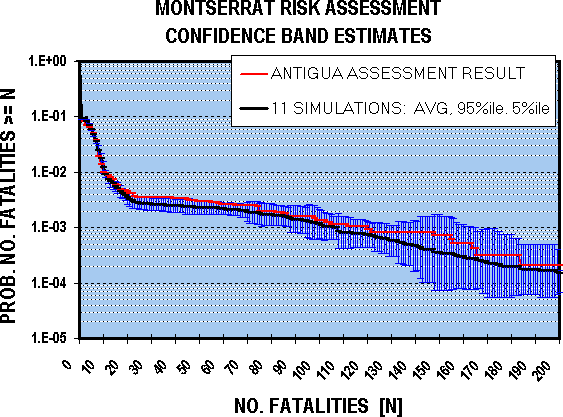 |
| Figure Addendum-1. (925x680 GIF, 17K) |
These curves indicate that uncertainty on the probability-of-exceedance values increases at low probabilities, such that the expected exceedance number of fatalities at the 1 in 1,000 level would be no less than 90, and may be high as 165 (cf. Table 3). The lower bound on this curve would just overlap the upper bound on a similar family of curves for the next scenario ("Strict exclusion zone", Fig. 3), making the difference in average values marginal in strict statistical terms (depending on the significance level chosen), but could not be intersected by the bound on the third scenario ("Pop. to zones 2 & 1"). This confirms that the differences in the scenario simulation results presented on Fig. 3 are meaningful, and that substantial reductions in risk could be achieved by moving the population progressively further north, as concluded.
The original single simulation result obtained from the preliminary QRA for the "Present population" scenario is also plotted on the accompanying figure, for comparative purposes. This curve can be seen to fall generally on the high side of average behaviour, near the 84%ile of the spread and, as an expression of the estimated risk, is therefore suitably conservative.
Appendix A: Hazard Report - Executive Summary
| Table C.2 Risk of an individual dying (D) in any one year or developing an adverse response (A) | |||
| Term used | Risk estimate | Example | |
| High | Greater than 1:100 | A. Transmission to susceptible household contacts of measles and chickenpox5 | 1:1-1:2 |
| A. Transmission of HIV from mother to child (Europe)2 | 1:6 | ||
| A. Gastro-intestinal effects of antibiotics4 | 1:10-1:20 | ||
| Moderate | Between 1:100-1:1,000 | D. Smoking 10 cigarettes per day1 | 1:200 |
| D. All natural causes, age 40 years1 | 1:850 | ||
| Low | Between 1:1,000-1:10,000 | D. All kinds of violence and poisoning1 | 1:3,300 |
| D. Influenza3 | 1:5,000 | ||
| D. Accident by road1 | 1:8,000 | ||
| Very low | Between 1:10,000-1:100,000 | D. Leukaemia1 | 1:12,000 |
| D. Playing soccer1 | 1:25,000 | ||
| D. Accident at home1 | 1:26,000 | ||
| D. Accident at work1 | 1:43,000 | ||
| D. Homicide1 | 1:100,000 | ||
| Minimal | Between 1:100,000-1:1,000,000 | D. Accident on railway1 | 1:500,000 |
| A. Vaccination-associated polio3 | 1:1,000,000 | ||
| Negligible | Less than 1:1,000,000 | D. Hit by lightning1 | 1:10,000,000 |
| D. Release of radiation by nuclear power station1 | 1:10,000,000 | ||
| Table C.3 Community risk scale | |||
| Risk | Risk magnitude | Risk description: (unit in which one adverse event would be expected) |
Example (based on No. of deaths in Britain per year) |
| 1 in 1 | 10 | Person | |
| 1 in 10 | 9 | Family | |
| 1 in 100 | 8 | Street | Any cause |
| 1 in 1,000 | 7 | Village | Any cause, age 40 |
| 1 in 10,000 | 6 | Small town | Road accident |
| 1 in 100,000 | 5 | Large town | Murder |
| 1 in 1,000,000 | 4 | City | Oral contraceptives |
| 1 in 10,000,000 | 3 | Province or country | Lightning |
| 1 in 100,000,000 | 2 | Large country | Measles |
| 1 in 1,000,000,000 | 1 | Continent | |
| 1 in 10,000,000,000 | 0 | World | |
Appendix D: Volcanological Input to Airfall Tephra Risk Assessment
The scientific aspects of modelling the tephra fall have been outlined in Appendix E.3 of the Hazards report. Models of tephra fall were developed for sustained explosive eruptions that are 3 times, 10 times and 30 times the intensity of the reference explosive eruption of 17 September 1996. It is assumed that increase in the intensity by a factor X corresponds to an increase in the magnitude of the eruption by a factor 2.5X. Model isopach (tephra thickness) and isopleth (maximum fragment size) maps were prepared for a small number of critical scenarios involving different assumptions about the wind speed and direction. The same principles could be applied to large numbers of permutations using a computer, but this option was not available to us in the short time given for the study. Such an investigation will require many months of work. The scenarios were selected for average meteorological conditions in the Caribbean and for conditions of a wind with the average regional wind velocity blowing to the northwest, which would maximise the impact on the currently populated areas. The probabilities of events which would maximise impact are much less than the event itself, because regional data over the last 14 years implies that winds blowing to the north-west or north only occur about 10% of the year. We note that winds here refer to those between 6 and 18 km altitude.
Preliminary inspection of the 3 times case indicated that even with unusual and disadvantageous wind conditions such an eruption would not have serious impact on the populated areas and so the study focussed on the larger events.
The combined isopach and isopleth map for each scenario was placed over the map of Montserrat and the thickness and proportions of 10 and 20 cm pumice fragments of density 1,000 kg/m3 were estimated at the main population centre in each of the population areas. Thickness estimates were given a formal error of 20%, based on comparisons of the models with real examples where the column height (proportional to intensity to about the 1/4 power) and wind conditions are known. The number of large clasts falling per unit area per unit time was estimated. 10 cm diameter pumice clasts were chosen because they are large enough to cause injury and 20 cm diameter clasts were chosen because they are certain to penetrate most roofs. The estimates of rates of large clast fall out are estimated on a limited data base as we know of only two studies where the proportions of large clasts in tephra deposits have been estimated. These studies suggest that the isopleth contours, commonly constructed as a measure of the range of large fragments, represent the one percentile of the distribution of all clasts depositing at a site. The uncertainty in this estimate is high and is given a formal value of 50%.
Only three scenarios were investigated in detail. In Scenario I a 10 times eruption occurs in a direction of 280° (the mean wind direction in the Caribbean in the 6 to 18 km range) and the mean wind velocity. In Scenario II the same eruption occurs with wind blowing to the northwest at the mean wind velocity. This event has an estimated probability of over 1 in 8,500, but the impact of such an event would be maximised. Variations of wind speed have the following qualitative effects. Wind speeds well below average would not have as great an impact, because more of the tephra would fall outside the populated areas closer to the volcano. Increasing the wind speed well above average would increase the impacted areas, but would produce slightly thinner deposits and would be a less probable event. In Scenario III a 30 times intensity eruption occurs under the average wind conditions. Wind conditions in such a very powerful eruption are less important, because the ejecta are spread significantly both cross-wind and upwind.
Effects are marginally greater than this scenario if the wind blows to the north at speeds greater than the average, but high altitude winds blow to the north much less than 10% of the year so the probability of both the event itself and adverse meteorological conditions is very low (over 1 in 50,000). Winds above 18 km predominantly blow to the east for much of the year. The eruption column for such an event is estimated at 34 km so the higher level winds will tend to further reduce the likelihood of the worst case.
Qualitatively the results indicate that the 3 times intensity eruption should not be a serious problem. People in all population areas would be advised to wear helmets and go indoors, but there appears little danger of roof collapse except in area 5 which is currently evacuated. The 10 times eruption would not pose problems for roof penetration by projectiles except in area 5 and large clast fall out is not considered a serious threat provided people go indoors promptly and wear protective head gear. The casualty figures for this scenario analysed by Mr. A. Pomonis thus largely relate to roof collapse. Scenario II has more impact than scenario I because the tephra fall is focused over the populated areas. The 30 times event will certainly create serious problems in areas 3, 4 and 5 and will impact areas 1 and 2 more marginally.
Appendix E: Engineering Input to Airfall Tephra Risk Assessment
This appendix is forthcoming.
| Table F.1 Population distribution for four models as used in the risk assessment. | |||||
| Population model | Area 5 | Area 4 | Area 3 | Area 2 | Area 1 |
| Current situation | 0 | 134 | 619 | 2248 | 1088 |
| Strict exclusion | 0 | 0 | 664 | 2288 | 1137 |
| North of Lawyer's | 0 | 0 | 0 | 2622 | 1467 |
| All in area 1 | 0 | 0 | 0 | 0 | 4089 |
Table F.2 gives the actual probabilities and factors used in the Monte Carlo simulation, with uncertainty ranges where appropriate.
Appendix G: Ability to Give Warnings
The Soufriere Hills volcano has continued to erupt for two and a half years and the MVO scientists are learning some of the empirical rules that govern its behaviour. The reasons for particular kinds of behaviour pattern are not fully understood so it is often a matter of recognising sequences of events or styles of behaviour that lead into the larger and more hazardous eruptions. It would be exaggerating to describe this as prediction, but rather a process of recognising features in the volcano's activity which can lead to more dangerous eruptions and thus being more alert to the dangers during these periods.
Major pyroclastic flows by dome collapse are generally preceded by growth of the dome into an unstable configuration. As the dome grows larger and taller in general the greater the chance that that a large-scale collapse will occur. On several occasions, including before the 25 June 1997 eruption, the dome has grown over one of the flanks and a large collapse has been anticipated several days or weeks before it happened. Some large collapses have also been preceded by significant changes in ground deformation patterns and earthquake activity. There was for example a major and abrupt change in tilt behaviour coupled with reinvigorated earthquake activity four days before the major collapse of the dome on 25 June. A similar change occurred before the major late July pyroclastic flows and explosive activity in early August. Earlier changes deeper in the plumbing system were indicated by significant changes in wide-area ground deformation during mid-March 1997.
All major periods of explosive activity have occurred following major dome collapses, so the chances of explosive volcanism a few hours or days after a major collapse period are much increased. The dome grows in pulses with the locus of dome growth remaining stable and generating rock falls and pyroclastic flows in particular sectors. After several days or weeks in a stable configuration the dome can switch to a new place. There are often premonitory signs of a switch, such as renewed fumarolic activity and changes in earthquake patterns. Once the switch has happened then the chances of, for example, pyroclastic flows threatening particular places, changes. For example the dome is currently (12 December 1997) growing in the south-west sector and pyroclastic flows are going down the White River valley. The threat to area 4 and the Belham Valley is thus currently reduced.
MVO has recognised remarkable cyclic patterns of ground tilt and earthquake swarms which are intimately related to dome growth activity. Cycles range from a few hours to a few days with periods of 6 to 14 hours being most common. Inflation of the volcano is accompanied by shallow earthquake swarms and reduced or no dome growth. Deflations coincide with one or more of the following phenomena: reduced earthquake activity or aseismic periods, invigorated dome growth, pyroclastic flow production, episodes of vigorous gas production and explosions. The cycles can be quite regular so that periods of reduced and enhanced danger can be recognised. The patterns, however, eventually break down after a few days or weeks so the forecasting ability that the pattern recognition provides cannot be extended far into the future.
Longer term changes that might lead into far more serious activity are more difficult to identify. There is a general view amongst the scientists that major eruptions (that is much larger than hitherto seen) would require a significant change in eruptive pattern and would likely be detected by monitoring, with ground deformation likely to play a key role.